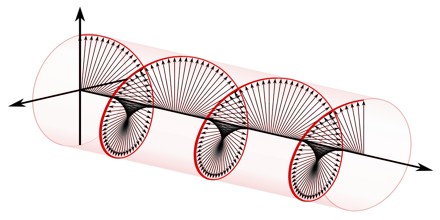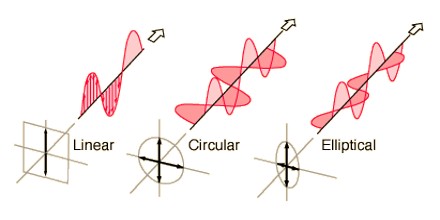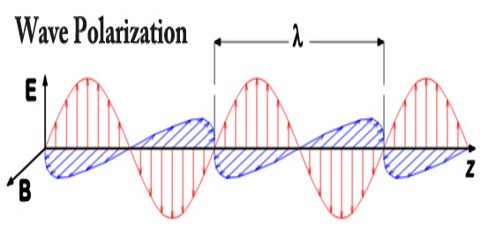Wave Polarization
Definition
Wave Polarization is an expression of the orientation of the lines of electric flux in an electromagnetic field (EM field). Polarization can be constant that is, existing in a particular orientation at all times, or it can rotate with each wave cycle. In a transverse wave the direction of the oscillation is transverse to the direction of motion of the wave, so the oscillations can have different directions perpendicular to the wave direction.

Polarization is important in wireless communications systems. The physical orientation of a wireless antenna corresponds to the polarization of the radio waves received or transmitted by that antenna. The best short-range communications is obtained when the transmitting and receiving antennas have the same polarization. The least efficient short-range communications usually takes place when the two antennas are at right angles for example, one horizontal and one vertical. Over long distances, the atmosphere can cause the polarization of a radio wave to fluctuate, so the distinction between horizontal and vertical becomes less significant.
An electromagnetic wave such as light consists of a coupled oscillating electric field and magnetic field which are always perpendicular; by convention the “polarization” of electromagnetic waves refers to the direction of the electric field. In linear polarization the fields oscillate in a single direction. In circular or elliptical polarization the fields rotate at a constant rate in a plane as the wave travels. The rotation can have two possible directions; if the fields rotate in a right hand sense with respect to the direction of wave travel it is called right circular polarization, if the fields rotate in a left hand sense it is called left circular polarization.

Dimensions (Classification) of Wave Polarization
Wave Polarization is not a particularly easy concept to visualize. It takes place in three dimensions and across time. Polarized waves have a fixed, constant orientation and create a path that is shaped like a flat plane as it travels through space.
Linear Polarization – A plane electromagnetic (EM) wave is characterized by electric and magnetic fields traveling in a single direction , with no field variation in the two orthogonal directions. In this case, the electric field and the magnetic field are perpendicular to each other and to the direction the plane wave is propagating. As an example, consider the single frequency E-field, where the field is traveling in the +z-direction, the E-field is oriented in the +x-direction, and the magnetic field is in the +y-direction.
Circular Polarization – Circularly polarized light consists of two perpendicular electromagnetic plane waves of equal amplitude and 90° difference in phase. The light illustrated is right- circularly polarized. If light is composed of two plane waves of equal amplitude but differing in phase by 90°, then the light is said to be circularly polarized.
Elliptical Polarization – Elliptically polarized light consists of two perpendicular waves of unequal amplitude which differ in phase by 90°. The illustration shows right- elliptically polarized light. In addition, elliptical polarization can be defined by its axial ratio, which is the ratio of the major and minor axis amplitudes.

Polarization of Antennas
The polarization of an antenna is the polarization of the radiated fields produced by an antenna, evaluated in the far field. Hence, antennas are often classified as “Linearly Polarized” or a “Right Hand Circularly Polarized Antenna” (RCHP).
This simple concept is important for antenna to antenna communication. First, a horizontally polarized antenna will not communicate with a vertically polarized antenna. Due to the reciprocity theorem, antennas transmit and receive in exactly the same manner. Hence, a vertically polarized antenna transmits and receives vertically polarized fields. Consequently, if a horizontally polarized antenna is trying to communicate with a vertically polarized antenna, there will be no reception.
Circular polarization is a desirable characteristic for many antennas. Two antennas that are both circularly polarized do not suffer signal loss due to polarization mismatch. Another advantage of circular polarization is that a RHCP wave will reflect off a surface and be LHCP. This is advantageous because an antenna designed to receive RHCP waves will have some immunity to the signal-fading effects of reflected waves interfering with the desired wave. These are some of the reasons GPS signals from satellites are RHCP.

Polarization of Electromagnetic Waves
An electromagnetic wave is a wave that is capable of transmitting its energy through a vacuum (i.e., empty space). Electromagnetic waves are produced by the vibration of charged particles. Electromagnetic waves that are produced on the sun subsequently travel to Earth through the vacuum of outer space. Were it not for the ability of electromagnetic waves to travel to through a vacuum, there would undoubtedly be no life on Earth. All light waves are examples of electromagnetic waves.
















